Deck 9: Conics, Systems of Nonlinear Equations and Inequalities, and Parametric Equations
سؤال
سؤال
سؤال
سؤال
سؤال
سؤال
سؤال
سؤال
سؤال
سؤال
سؤال
سؤال
سؤال
سؤال
سؤال
سؤال
سؤال
سؤال
سؤال
سؤال
سؤال
سؤال
سؤال
سؤال
سؤال
سؤال
سؤال
سؤال
سؤال
سؤال
سؤال
سؤال
سؤال
سؤال
سؤال
سؤال
سؤال
سؤال
سؤال
سؤال
سؤال
سؤال
سؤال
سؤال
سؤال
سؤال
سؤال
سؤال
سؤال
سؤال
سؤال
سؤال
سؤال
سؤال
سؤال
سؤال
سؤال
سؤال
سؤال
سؤال
سؤال
سؤال
سؤال
سؤال
سؤال
سؤال
سؤال
سؤال
سؤال
سؤال
سؤال
سؤال
سؤال
سؤال
سؤال
سؤال
سؤال
سؤال
سؤال
سؤال

فتح الحزمة
قم بالتسجيل لفتح البطاقات في هذه المجموعة!
Unlock Deck
Unlock Deck
1/230
العب
ملء الشاشة (f)
Deck 9: Conics, Systems of Nonlinear Equations and Inequalities, and Parametric Equations
1
Graph the curve defined by the parametric equations.
x= t , y= t2 , t in [-2, 2]
x= t , y= t2 , t in [-2, 2]

2
Graph the curve defined by the parametric equations.
![Graph the curve defined by the parametric equations. , ,t in [0, 2π]](https://d2lvgg3v3hfg70.cloudfront.net/TB10663/11eed1b2_575d_9a14_a8a5_d53b9504a056_TB10663_00.jpg) ,
, ![Graph the curve defined by the parametric equations. , ,t in [0, 2π]](https://d2lvgg3v3hfg70.cloudfront.net/TB10663/11eed1b2_575d_9a15_a8a5_1b57be2bb7b9_TB10663_00.jpg) ,t in [0, 2π]
,t in [0, 2π]
![Graph the curve defined by the parametric equations. , ,t in [0, 2π]](https://d2lvgg3v3hfg70.cloudfront.net/TB10663/11eed1b2_575d_9a14_a8a5_d53b9504a056_TB10663_00.jpg) ,
, ![Graph the curve defined by the parametric equations. , ,t in [0, 2π]](https://d2lvgg3v3hfg70.cloudfront.net/TB10663/11eed1b2_575d_9a15_a8a5_1b57be2bb7b9_TB10663_00.jpg) ,t in [0, 2π]
,t in [0, 2π]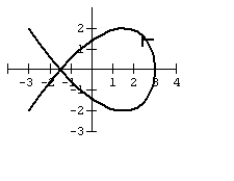
3
Graph the curve defined by the parametric equations.
![Graph the curve defined by the parametric equations. ,y=t,t in [0, 2π]](https://d2lvgg3v3hfg70.cloudfront.net/TB10663/11eed1b2_575d_9a17_a8a5_ad47cfa028f0_TB10663_00.jpg) ,y=t,t in [0, 2π]
,y=t,t in [0, 2π]
![Graph the curve defined by the parametric equations. ,y=t,t in [0, 2π]](https://d2lvgg3v3hfg70.cloudfront.net/TB10663/11eed1b2_575d_9a17_a8a5_ad47cfa028f0_TB10663_00.jpg) ,y=t,t in [0, 2π]
,y=t,t in [0, 2π]
4
Graph the curve defined by the parametric equations.
![Graph the curve defined by the parametric equations. , ,t in [0, 1]](https://d2lvgg3v3hfg70.cloudfront.net/TB10663/11eed1b2_575d_9a19_a8a5_bdf37051c310_TB10663_00.jpg) ,
, ![Graph the curve defined by the parametric equations. , ,t in [0, 1]](https://d2lvgg3v3hfg70.cloudfront.net/TB10663/11eed1b2_575d_9a1a_a8a5_f1c961783a67_TB10663_00.jpg) ,t in [0, 1]
,t in [0, 1]
![Graph the curve defined by the parametric equations. , ,t in [0, 1]](https://d2lvgg3v3hfg70.cloudfront.net/TB10663/11eed1b2_575d_9a19_a8a5_bdf37051c310_TB10663_00.jpg) ,
, ![Graph the curve defined by the parametric equations. , ,t in [0, 1]](https://d2lvgg3v3hfg70.cloudfront.net/TB10663/11eed1b2_575d_9a1a_a8a5_f1c961783a67_TB10663_00.jpg) ,t in [0, 1]
,t in [0, 1]
فتح الحزمة
افتح القفل للوصول البطاقات البالغ عددها 230 في هذه المجموعة.
فتح الحزمة
k this deck
5
Graph the curve defined by the parametric equations.
![Graph the curve defined by the parametric equations. , ,t in [0, 2π]](https://d2lvgg3v3hfg70.cloudfront.net/TB10663/11eed1b2_575d_9a1c_a8a5_a7145e9d4d96_TB10663_00.jpg) ,
, ![Graph the curve defined by the parametric equations. , ,t in [0, 2π]](https://d2lvgg3v3hfg70.cloudfront.net/TB10663/11eed1b2_575d_9a1d_a8a5_c5fff45959d3_TB10663_00.jpg) ,t in [0, 2π]
,t in [0, 2π]
![Graph the curve defined by the parametric equations. , ,t in [0, 2π]](https://d2lvgg3v3hfg70.cloudfront.net/TB10663/11eed1b2_575d_9a1c_a8a5_a7145e9d4d96_TB10663_00.jpg) ,
, ![Graph the curve defined by the parametric equations. , ,t in [0, 2π]](https://d2lvgg3v3hfg70.cloudfront.net/TB10663/11eed1b2_575d_9a1d_a8a5_c5fff45959d3_TB10663_00.jpg) ,t in [0, 2π]
,t in [0, 2π]
فتح الحزمة
افتح القفل للوصول البطاقات البالغ عددها 230 في هذه المجموعة.
فتح الحزمة
k this deck
6
Graph the curve defined by the parametric equations.
![Graph the curve defined by the parametric equations. , ,t in [0, 2π]](https://d2lvgg3v3hfg70.cloudfront.net/TB10663/11eed1b2_575d_9a1f_a8a5_b19069536c98_TB10663_00.jpg) ,
, ![Graph the curve defined by the parametric equations. , ,t in [0, 2π]](https://d2lvgg3v3hfg70.cloudfront.net/TB10663/11eed1b2_575d_9a20_a8a5_f7d09269dc66_TB10663_00.jpg) ,t in [0, 2π]
,t in [0, 2π]
![Graph the curve defined by the parametric equations. , ,t in [0, 2π]](https://d2lvgg3v3hfg70.cloudfront.net/TB10663/11eed1b2_575d_9a1f_a8a5_b19069536c98_TB10663_00.jpg) ,
, ![Graph the curve defined by the parametric equations. , ,t in [0, 2π]](https://d2lvgg3v3hfg70.cloudfront.net/TB10663/11eed1b2_575d_9a20_a8a5_f7d09269dc66_TB10663_00.jpg) ,t in [0, 2π]
,t in [0, 2π]
فتح الحزمة
افتح القفل للوصول البطاقات البالغ عددها 230 في هذه المجموعة.
فتح الحزمة
k this deck
7
Graph the curve defined by the parametric equations.
![Graph the curve defined by the parametric equations. , ,t in [-π/4,π/4]](https://d2lvgg3v3hfg70.cloudfront.net/TB10663/11eed1b2_575d_c132_a8a5_23b1280af6ba_TB10663_00.jpg) ,
, ![Graph the curve defined by the parametric equations. , ,t in [-π/4,π/4]](https://d2lvgg3v3hfg70.cloudfront.net/TB10663/11eed1b2_575d_c133_a8a5_211dfd65d254_TB10663_00.jpg) ,t in [-π/4,π/4]
,t in [-π/4,π/4]
![Graph the curve defined by the parametric equations. , ,t in [-π/4,π/4]](https://d2lvgg3v3hfg70.cloudfront.net/TB10663/11eed1b2_575d_c132_a8a5_23b1280af6ba_TB10663_00.jpg) ,
, ![Graph the curve defined by the parametric equations. , ,t in [-π/4,π/4]](https://d2lvgg3v3hfg70.cloudfront.net/TB10663/11eed1b2_575d_c133_a8a5_211dfd65d254_TB10663_00.jpg) ,t in [-π/4,π/4]
,t in [-π/4,π/4]
فتح الحزمة
افتح القفل للوصول البطاقات البالغ عددها 230 في هذه المجموعة.
فتح الحزمة
k this deck
8
The given parametric equations define a plane curve. Find an equation in rectangular form that also corresponds to the plane curve.
 ,
, 
 ,
, 

فتح الحزمة
افتح القفل للوصول البطاقات البالغ عددها 230 في هذه المجموعة.
فتح الحزمة
k this deck
9
The given parametric equations define a plane curve. Find an equation in rectangular form that also corresponds to the plane curve.
 ,
, 
 ,
, 

فتح الحزمة
افتح القفل للوصول البطاقات البالغ عددها 230 في هذه المجموعة.
فتح الحزمة
k this deck
10
The given parametric equations define a plane curve. Find an equation in rectangular form that also corresponds to the plane curve.
 ,
, 
 ,
, 

فتح الحزمة
افتح القفل للوصول البطاقات البالغ عددها 230 في هذه المجموعة.
فتح الحزمة
k this deck
11
The given parametric equations define a plane curve. Find an equation in rectangular form that also corresponds to the plane curve.



فتح الحزمة
افتح القفل للوصول البطاقات البالغ عددها 230 في هذه المجموعة.
فتح الحزمة
k this deck
12
The given parametric equations define a plane curve. Find an equation in rectangular form that also corresponds to the plane curve.
 ,
, 
 ,
, 

فتح الحزمة
افتح القفل للوصول البطاقات البالغ عددها 230 في هذه المجموعة.
فتح الحزمة
k this deck
13
Recall that the flight of a projectile can be modeled with the parametric equations:
 ,
,  where t is in seconds, νo is the initial velocity, θ is the angle with the horizontal, and x and y are in feet.
where t is in seconds, νo is the initial velocity, θ is the angle with the horizontal, and x and y are in feet.
A projectile is launched at a speed of 560 ft/sec at an angle of 47° with the horizontal. After how many seconds does the projectile hit the ground? Round to one decimal place.
 ,
,  where t is in seconds, νo is the initial velocity, θ is the angle with the horizontal, and x and y are in feet.
where t is in seconds, νo is the initial velocity, θ is the angle with the horizontal, and x and y are in feet.A projectile is launched at a speed of 560 ft/sec at an angle of 47° with the horizontal. After how many seconds does the projectile hit the ground? Round to one decimal place.

فتح الحزمة
افتح القفل للوصول البطاقات البالغ عددها 230 في هذه المجموعة.
فتح الحزمة
k this deck
14
Recall that the flight of a projectile can be modeled with the parametric equations:
 ,
, 
where t is in seconds, νo is the initial velocity, θ is the angle with the horizontal, and x and y are in feet.
A projectile is launched at a speed of 465 ft/sec at an angle of 33° with the horizontal. How far does the projectile travel (what is the horizontal distance), and what is the maximum altitude? Round to the nearest integer.
 ,
, 
where t is in seconds, νo is the initial velocity, θ is the angle with the horizontal, and x and y are in feet.
A projectile is launched at a speed of 465 ft/sec at an angle of 33° with the horizontal. How far does the projectile travel (what is the horizontal distance), and what is the maximum altitude? Round to the nearest integer.

فتح الحزمة
افتح القفل للوصول البطاقات البالغ عددها 230 في هذه المجموعة.
فتح الحزمة
k this deck
15
Recall that the flight of a projectile can be modeled with the parametric equations:
 ,
, 
where t is in seconds, νo is the initial velocity, θ is the angle with the horizontal, and x and y are in feet.
A baseball is hit at an initial speed of 115 mph and angle of 32° at a height of 2 feet above the ground. If home plate is 425 feet from the back fence, which is 12 feet tall, will the baseball clear the back fence for a home run?
 ,
, 
where t is in seconds, νo is the initial velocity, θ is the angle with the horizontal, and x and y are in feet.
A baseball is hit at an initial speed of 115 mph and angle of 32° at a height of 2 feet above the ground. If home plate is 425 feet from the back fence, which is 12 feet tall, will the baseball clear the back fence for a home run?

فتح الحزمة
افتح القفل للوصول البطاقات البالغ عددها 230 في هذه المجموعة.
فتح الحزمة
k this deck
16
Recall that the flight of a projectile can be modeled with the parametric equations:
 ,
,  where t is in seconds, νo is the initial velocity, θ is the angle with the horizontal, and x and y are in feet.
where t is in seconds, νo is the initial velocity, θ is the angle with the horizontal, and x and y are in feet.
A baseball is hit at an initial speed of 110 mph and angle of 31° at a height of 2 feet above the ground. If there's no back fence or other obstruction, how far does the baseball travel (horizontal distance), and what is the maximum height? Round to one decimal place.
 ,
,  where t is in seconds, νo is the initial velocity, θ is the angle with the horizontal, and x and y are in feet.
where t is in seconds, νo is the initial velocity, θ is the angle with the horizontal, and x and y are in feet.A baseball is hit at an initial speed of 110 mph and angle of 31° at a height of 2 feet above the ground. If there's no back fence or other obstruction, how far does the baseball travel (horizontal distance), and what is the maximum height? Round to one decimal place.

فتح الحزمة
افتح القفل للوصول البطاقات البالغ عددها 230 في هذه المجموعة.
فتح الحزمة
k this deck
17
Recall that the flight of a projectile can be modeled with the parametric equations:
 ,
,  where t is in seconds, νo is the initial velocity, θ is the angle with the horizontal, and x and y are in feet.
where t is in seconds, νo is the initial velocity, θ is the angle with the horizontal, and x and y are in feet.
A gun is fired at an angle of 21°, and the bullet has an initial speed of 875 feet per second. How high does the bullet go, and when does it hit the ground? Round the altitude to the nearest foot and time to the nearest tenth of a second.
 ,
,  where t is in seconds, νo is the initial velocity, θ is the angle with the horizontal, and x and y are in feet.
where t is in seconds, νo is the initial velocity, θ is the angle with the horizontal, and x and y are in feet.A gun is fired at an angle of 21°, and the bullet has an initial speed of 875 feet per second. How high does the bullet go, and when does it hit the ground? Round the altitude to the nearest foot and time to the nearest tenth of a second.

فتح الحزمة
افتح القفل للوصول البطاقات البالغ عددها 230 في هذه المجموعة.
فتح الحزمة
k this deck
18
Recall that the flight of a projectile can be modeled with the parametric equations:
 ,
,  where t is in seconds, νo is the initial velocity, θ is the angle with the horizontal, and x and y are in feet.
where t is in seconds, νo is the initial velocity, θ is the angle with the horizontal, and x and y are in feet.
A missile is fired from a ship at an angle of 32°, an initial height of 20 feet above the water's surface, and at a speed of 4450 feet per second. How long will it be before the missile hits the water? Round to the nearest tenth of a second.
 ,
,  where t is in seconds, νo is the initial velocity, θ is the angle with the horizontal, and x and y are in feet.
where t is in seconds, νo is the initial velocity, θ is the angle with the horizontal, and x and y are in feet.A missile is fired from a ship at an angle of 32°, an initial height of 20 feet above the water's surface, and at a speed of 4450 feet per second. How long will it be before the missile hits the water? Round to the nearest tenth of a second.

فتح الحزمة
افتح القفل للوصول البطاقات البالغ عددها 230 في هذه المجموعة.
فتح الحزمة
k this deck
19
Recall that the flight of a projectile can be modeled with the parametric equations:
 ,
,  where t is in seconds, νo is the initial velocity, θ is the angle with the horizontal, and x and y are in feet.
where t is in seconds, νo is the initial velocity, θ is the angle with the horizontal, and x and y are in feet.
A missile is fired from a ship at an angle of 56°, an initial height of 18 feet above the water's surface, and at a speed of 4430 feet per second. Will it be able to hit a target that is 2.4 miles away?
 ,
,  where t is in seconds, νo is the initial velocity, θ is the angle with the horizontal, and x and y are in feet.
where t is in seconds, νo is the initial velocity, θ is the angle with the horizontal, and x and y are in feet.A missile is fired from a ship at an angle of 56°, an initial height of 18 feet above the water's surface, and at a speed of 4430 feet per second. Will it be able to hit a target that is 2.4 miles away?

فتح الحزمة
افتح القفل للوصول البطاقات البالغ عددها 230 في هذه المجموعة.
فتح الحزمة
k this deck
20
Recall that the flight of a projectile can be modeled with the parametric equations:
 ,
,  where t is in seconds, νo is the initial velocity, θ is the angle with the horizontal, and x and y are in feet.
where t is in seconds, νo is the initial velocity, θ is the angle with the horizontal, and x and y are in feet.
A projectile is launched at a speed of 200 ft/sec at an angle of 30° with the horizontal. Plot the path of the projectile on a graph.
 ,
,  where t is in seconds, νo is the initial velocity, θ is the angle with the horizontal, and x and y are in feet.
where t is in seconds, νo is the initial velocity, θ is the angle with the horizontal, and x and y are in feet.A projectile is launched at a speed of 200 ft/sec at an angle of 30° with the horizontal. Plot the path of the projectile on a graph.

فتح الحزمة
افتح القفل للوصول البطاقات البالغ عددها 230 في هذه المجموعة.
فتح الحزمة
k this deck
21
Graph the curve defined by the parametric equations.

A)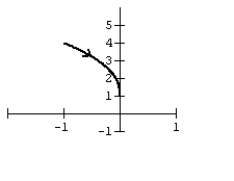
B)
C)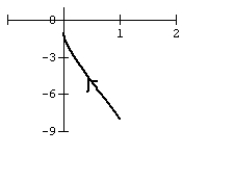
D)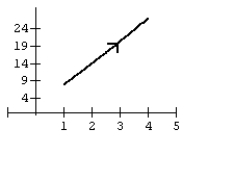

A)

B)

C)

D)


فتح الحزمة
افتح القفل للوصول البطاقات البالغ عددها 230 في هذه المجموعة.
فتح الحزمة
k this deck
22
Graph the curve defined by the parametric equations.

A)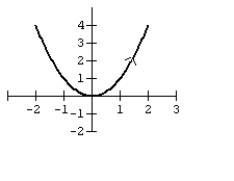
B)
C)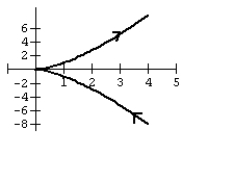
D)

A)

B)

C)

D)


فتح الحزمة
افتح القفل للوصول البطاقات البالغ عددها 230 في هذه المجموعة.
فتح الحزمة
k this deck
23
Graph the curve defined by the parametric equations.

A)
B)
C)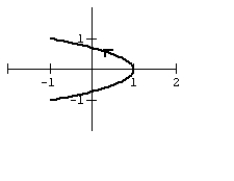
D)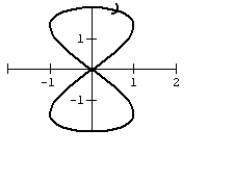

A)

B)

C)

D)


فتح الحزمة
افتح القفل للوصول البطاقات البالغ عددها 230 في هذه المجموعة.
فتح الحزمة
k this deck
24
Graph the curve defined by the parametric equations.

A)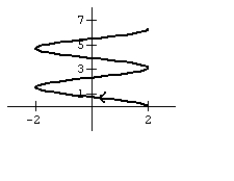
B)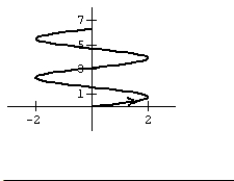
C)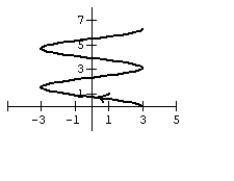
D)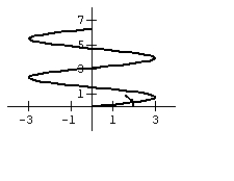

A)

B)

C)

D)


فتح الحزمة
افتح القفل للوصول البطاقات البالغ عددها 230 في هذه المجموعة.
فتح الحزمة
k this deck
25
Graph the curve defined by the parametric equations.

A)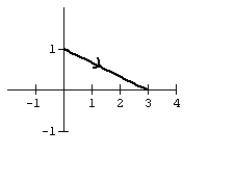
B)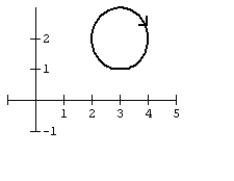
C)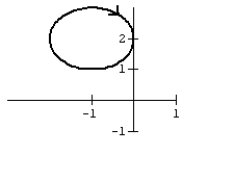
D)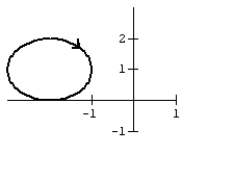

A)

B)

C)

D)


فتح الحزمة
افتح القفل للوصول البطاقات البالغ عددها 230 في هذه المجموعة.
فتح الحزمة
k this deck
26
Graph the curve defined by the parametric equations.

A)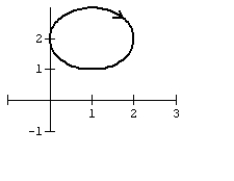
B)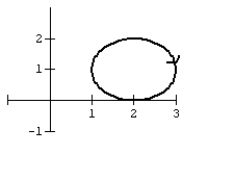
C)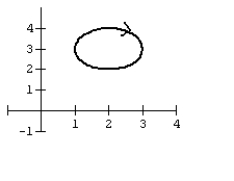
D)

A)

B)

C)

D)


فتح الحزمة
افتح القفل للوصول البطاقات البالغ عددها 230 في هذه المجموعة.
فتح الحزمة
k this deck
27
Graph the curve defined by the parametric equations.

A)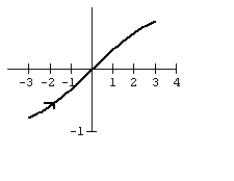
B)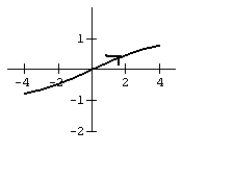
C)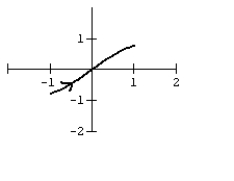
D)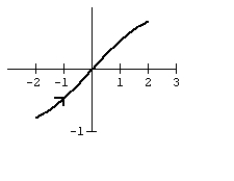

A)

B)

C)

D)


فتح الحزمة
افتح القفل للوصول البطاقات البالغ عددها 230 في هذه المجموعة.
فتح الحزمة
k this deck
28
The given parametric equations define a plane curve. Find an equation in rectangular form that also corresponds to the plane curve.
 ,
, 
A)
B)
C)
D)
 ,
, 
A)

B)

C)

D)


فتح الحزمة
افتح القفل للوصول البطاقات البالغ عددها 230 في هذه المجموعة.
فتح الحزمة
k this deck
29
The given parametric equations define a plane curve. Find an equation in rectangular form that also corresponds to the plane curve.
 ,
, 
A)
B)
C)
D)
 ,
, 
A)

B)

C)

D)


فتح الحزمة
افتح القفل للوصول البطاقات البالغ عددها 230 في هذه المجموعة.
فتح الحزمة
k this deck
30
The given parametric equations define a plane curve. Find an equation in rectangular form that also corresponds to the plane curve.
 ,
, 
A)
B)
C)
D)
 ,
, 
A)

B)

C)

D)


فتح الحزمة
افتح القفل للوصول البطاقات البالغ عددها 230 في هذه المجموعة.
فتح الحزمة
k this deck
31
The given parametric equations define a plane curve. Find an equation in rectangular form that also corresponds to the plane curve.
 ,
, 
A)
B)
C)
D)
 ,
, 
A)

B)

C)

D)


فتح الحزمة
افتح القفل للوصول البطاقات البالغ عددها 230 في هذه المجموعة.
فتح الحزمة
k this deck
32
Recall that the flight of a projectile can be modeled with the parametric equations:
 ,
,  where t is in seconds, vo is the initial velocity, is the angle with the horizontal, and x and y are in feet.
where t is in seconds, vo is the initial velocity, is the angle with the horizontal, and x and y are in feet.
A projectile is launched at a speed of 420 ft/sec at an angle of 37° with the horizontal. After how many seconds does the projectile hit the ground? Round to one decimal place.
A) 15.8 seconds
B) 31.6 seconds
C) 7.9 seconds
D) 21.0 seconds
 ,
,  where t is in seconds, vo is the initial velocity, is the angle with the horizontal, and x and y are in feet.
where t is in seconds, vo is the initial velocity, is the angle with the horizontal, and x and y are in feet.A projectile is launched at a speed of 420 ft/sec at an angle of 37° with the horizontal. After how many seconds does the projectile hit the ground? Round to one decimal place.
A) 15.8 seconds
B) 31.6 seconds
C) 7.9 seconds
D) 21.0 seconds

فتح الحزمة
افتح القفل للوصول البطاقات البالغ عددها 230 في هذه المجموعة.
فتح الحزمة
k this deck
33
Recall that the flight of a projectile can be modeled with the parametric equations:
 ,
,  where t is in seconds, vo is the initial velocity, is the angle with the horizontal, and x and y are in feet.
where t is in seconds, vo is the initial velocity, is the angle with the horizontal, and x and y are in feet.
A projectile is launched at a speed of 520 ft/sec at an angle of 31° with the horizontal. How far does the projectile travel (what is the horizontal distance), and what is the maximum altitude? Round to the nearest integer.
A) 7,461 feet; 1,121 feet
B) 14,922 feet; 1,121 feet
C) 7,461 feet; 2,241 feet
D) 14,922 feet; 2,241 feet
 ,
,  where t is in seconds, vo is the initial velocity, is the angle with the horizontal, and x and y are in feet.
where t is in seconds, vo is the initial velocity, is the angle with the horizontal, and x and y are in feet.A projectile is launched at a speed of 520 ft/sec at an angle of 31° with the horizontal. How far does the projectile travel (what is the horizontal distance), and what is the maximum altitude? Round to the nearest integer.
A) 7,461 feet; 1,121 feet
B) 14,922 feet; 1,121 feet
C) 7,461 feet; 2,241 feet
D) 14,922 feet; 2,241 feet

فتح الحزمة
افتح القفل للوصول البطاقات البالغ عددها 230 في هذه المجموعة.
فتح الحزمة
k this deck
34
Recall that the flight of a projectile can be modeled with the parametric equations:
 ,
,  where t is in seconds, vo is the initial velocity, is the angle with the horizontal, and x and y are in feet.
where t is in seconds, vo is the initial velocity, is the angle with the horizontal, and x and y are in feet.
A baseball is hit at an initial speed of 100 mph and angle of 32° at a height of 3 feet above the ground. If home plate is 465 feet from the back fence, which is 19 feet tall, will the baseball clear the back fence for a home run?
A) Yes. The height will be over 19 feet at that time.
B) No. The height will not be over 19 feet at that time.
C) no solution
 ,
,  where t is in seconds, vo is the initial velocity, is the angle with the horizontal, and x and y are in feet.
where t is in seconds, vo is the initial velocity, is the angle with the horizontal, and x and y are in feet.A baseball is hit at an initial speed of 100 mph and angle of 32° at a height of 3 feet above the ground. If home plate is 465 feet from the back fence, which is 19 feet tall, will the baseball clear the back fence for a home run?
A) Yes. The height will be over 19 feet at that time.
B) No. The height will not be over 19 feet at that time.
C) no solution

فتح الحزمة
افتح القفل للوصول البطاقات البالغ عددها 230 في هذه المجموعة.
فتح الحزمة
k this deck
35
Recall that the flight of a projectile can be modeled with the parametric equations:
 ,
,  where t is in seconds, vo is the initial velocity, is the angle with the horizontal, and x and y are in feet.
where t is in seconds, vo is the initial velocity, is the angle with the horizontal, and x and y are in feet.
A baseball is hit at an initial speed of 110 mph and angle of 24° at a height of 5 feet above the ground. If there's no back fence or other obstruction, how far does the baseball travel (horizontal distance), and what is the maximum height? Round to one decimal place.
A) 615.5 feet; 72.3 feet
B) 604.5 feet; 72.3 feet
C) 615.5 feet; 67.3 feet
D) 604.5 feet; 165.4 feet
 ,
,  where t is in seconds, vo is the initial velocity, is the angle with the horizontal, and x and y are in feet.
where t is in seconds, vo is the initial velocity, is the angle with the horizontal, and x and y are in feet.A baseball is hit at an initial speed of 110 mph and angle of 24° at a height of 5 feet above the ground. If there's no back fence or other obstruction, how far does the baseball travel (horizontal distance), and what is the maximum height? Round to one decimal place.
A) 615.5 feet; 72.3 feet
B) 604.5 feet; 72.3 feet
C) 615.5 feet; 67.3 feet
D) 604.5 feet; 165.4 feet

فتح الحزمة
افتح القفل للوصول البطاقات البالغ عددها 230 في هذه المجموعة.
فتح الحزمة
k this deck
36
Recall that the flight of a projectile can be modeled with the parametric equations:
 ,
,  where t is in seconds, vo is the initial velocity, is the angle with the horizontal, and x and y are in feet.
where t is in seconds, vo is the initial velocity, is the angle with the horizontal, and x and y are in feet.
A gun is fired at an angle of 23°, and the bullet has an initial speed of 2345 feet per second. How high does the bullet go, and when does it hit the ground? Round the altitude to the nearest foot and time to the nearest tenth of a second.
A) 13,118 feet; 57.3 seconds
B) 26,236 feet; 57.3 seconds
C) 13,118 feet; 29 seconds
D) 33,573 feet; 29 seconds
 ,
,  where t is in seconds, vo is the initial velocity, is the angle with the horizontal, and x and y are in feet.
where t is in seconds, vo is the initial velocity, is the angle with the horizontal, and x and y are in feet.A gun is fired at an angle of 23°, and the bullet has an initial speed of 2345 feet per second. How high does the bullet go, and when does it hit the ground? Round the altitude to the nearest foot and time to the nearest tenth of a second.
A) 13,118 feet; 57.3 seconds
B) 26,236 feet; 57.3 seconds
C) 13,118 feet; 29 seconds
D) 33,573 feet; 29 seconds

فتح الحزمة
افتح القفل للوصول البطاقات البالغ عددها 230 في هذه المجموعة.
فتح الحزمة
k this deck
37
Recall that the flight of a projectile can be modeled with the parametric equations:
 ,
,  where t is in seconds, vo is the initial velocity, is the angle with the horizontal, and x and y are in feet.
where t is in seconds, vo is the initial velocity, is the angle with the horizontal, and x and y are in feet.
A missile is fired from a ship at an angle of 31°, an initial height of 13 feet above the water's surface, and at a speed of 5500 feet per second. How long will it be before the missile hits the water? Round to one decimal place.
A) 177.0 seconds
B) 354.1 seconds
C) 88.5 seconds
D) 294.7 seconds
 ,
,  where t is in seconds, vo is the initial velocity, is the angle with the horizontal, and x and y are in feet.
where t is in seconds, vo is the initial velocity, is the angle with the horizontal, and x and y are in feet.A missile is fired from a ship at an angle of 31°, an initial height of 13 feet above the water's surface, and at a speed of 5500 feet per second. How long will it be before the missile hits the water? Round to one decimal place.
A) 177.0 seconds
B) 354.1 seconds
C) 88.5 seconds
D) 294.7 seconds

فتح الحزمة
افتح القفل للوصول البطاقات البالغ عددها 230 في هذه المجموعة.
فتح الحزمة
k this deck
38
Recall that the flight of a projectile can be modeled with the parametric equations:
 ,
,  where t is in seconds, vo is the initial velocity, is the angle with the horizontal, and x and y are in feet.
where t is in seconds, vo is the initial velocity, is the angle with the horizontal, and x and y are in feet.
A missile is fired from a ship at an angle of 39°, an initial height of 20 feet above the water's surface, and at a speed of 3890 feet per second. Will it be able to hit a target that is 2.4 miles away?
A) Yes, it will easily hit the target.
B) No, it will miss the target.
C) no solution
 ,
,  where t is in seconds, vo is the initial velocity, is the angle with the horizontal, and x and y are in feet.
where t is in seconds, vo is the initial velocity, is the angle with the horizontal, and x and y are in feet.A missile is fired from a ship at an angle of 39°, an initial height of 20 feet above the water's surface, and at a speed of 3890 feet per second. Will it be able to hit a target that is 2.4 miles away?
A) Yes, it will easily hit the target.
B) No, it will miss the target.
C) no solution

فتح الحزمة
افتح القفل للوصول البطاقات البالغ عددها 230 في هذه المجموعة.
فتح الحزمة
k this deck
39
Recall that the flight of a projectile can be modeled with the parametric equations:
 ,
,  where t is in seconds, vo is the initial velocity, is the angle with the horizontal, and x and y are in feet.
where t is in seconds, vo is the initial velocity, is the angle with the horizontal, and x and y are in feet.
A projectile is launched at a speed of 200 ft/sec at an angle of 60° with the horizontal. Plot the path of the projectile on a graph.
A)
B)
C)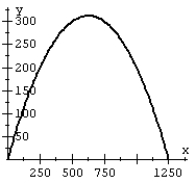
D)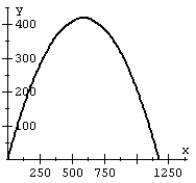
 ,
,  where t is in seconds, vo is the initial velocity, is the angle with the horizontal, and x and y are in feet.
where t is in seconds, vo is the initial velocity, is the angle with the horizontal, and x and y are in feet.A projectile is launched at a speed of 200 ft/sec at an angle of 60° with the horizontal. Plot the path of the projectile on a graph.
A)

B)

C)

D)


فتح الحزمة
افتح القفل للوصول البطاقات البالغ عددها 230 في هذه المجموعة.
فتح الحزمة
k this deck
40
The given rectangular equation defines a plane curve. Find the parametric equations that also corresponds to the plane curve.



فتح الحزمة
افتح القفل للوصول البطاقات البالغ عددها 230 في هذه المجموعة.
فتح الحزمة
k this deck
41
The given rectangular equation defines a plane curve. Find the parametric equations that also corresponds to the plane curve.



فتح الحزمة
افتح القفل للوصول البطاقات البالغ عددها 230 في هذه المجموعة.
فتح الحزمة
k this deck
42
The given rectangular equation defines a plane curve. Find the parametric equations that also corresponds to the plane curve.



فتح الحزمة
افتح القفل للوصول البطاقات البالغ عددها 230 في هذه المجموعة.
فتح الحزمة
k this deck
43
The given rectangular equation defines a plane curve. Find the parametric equations that also corresponds to the plane curve.



فتح الحزمة
افتح القفل للوصول البطاقات البالغ عددها 230 في هذه المجموعة.
فتح الحزمة
k this deck
44
The given rectangular equation defines a plane curve. Find the parametric equations that also corresponds to the plane curve.



فتح الحزمة
افتح القفل للوصول البطاقات البالغ عددها 230 في هذه المجموعة.
فتح الحزمة
k this deck
45
Find the polar equation that represents the conic described (assume the focus is at the origin).
Ellipse with eccentricity e =

and directrix

Ellipse with eccentricity e =

and directrix


فتح الحزمة
افتح القفل للوصول البطاقات البالغ عددها 230 في هذه المجموعة.
فتح الحزمة
k this deck
46
Find the polar equation that represents the conic described (assume the focus is at the origin).
Hyperbola with eccentricity e =

and directrix

Hyperbola with eccentricity e =

and directrix


فتح الحزمة
افتح القفل للوصول البطاقات البالغ عددها 230 في هذه المجموعة.
فتح الحزمة
k this deck
47
Find the polar equation that represents the conic described (assume the focus is at the origin).
Parabola with eccentricity e =1 and directrix

Parabola with eccentricity e =1 and directrix


فتح الحزمة
افتح القفل للوصول البطاقات البالغ عددها 230 في هذه المجموعة.
فتح الحزمة
k this deck
48
Identify the conic that the polar equation represents.



فتح الحزمة
افتح القفل للوصول البطاقات البالغ عددها 230 في هذه المجموعة.
فتح الحزمة
k this deck
49
Identify the conic that the polar equation represents.



فتح الحزمة
افتح القفل للوصول البطاقات البالغ عددها 230 في هذه المجموعة.
فتح الحزمة
k this deck
50
Identify the conic that the polar equation represents.



فتح الحزمة
افتح القفل للوصول البطاقات البالغ عددها 230 في هذه المجموعة.
فتح الحزمة
k this deck
51
For the polar equation, (a) Identify the conic as either a parabola, ellipse, or hyperbola; (b) find the eccentricity and vertex (or vertices); and (c) graph.



فتح الحزمة
افتح القفل للوصول البطاقات البالغ عددها 230 في هذه المجموعة.
فتح الحزمة
k this deck
52
For the polar equation, (a) Identify the conic as either a parabola, ellipse, or hyperbola; (b) find the eccentricity and vertex (or vertices); and (c) graph.



فتح الحزمة
افتح القفل للوصول البطاقات البالغ عددها 230 في هذه المجموعة.
فتح الحزمة
k this deck
53
For the polar equation, graph the conic. 
A)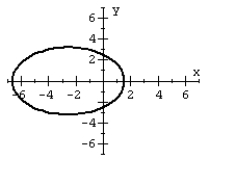
B)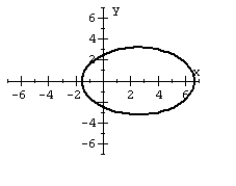
C)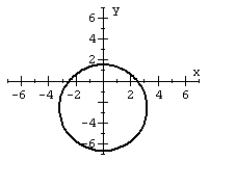
D)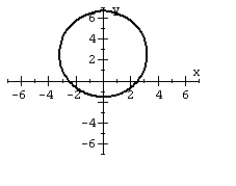

A)

B)

C)

D)


فتح الحزمة
افتح القفل للوصول البطاقات البالغ عددها 230 في هذه المجموعة.
فتح الحزمة
k this deck
54
For the polar equation, graph the conic. 
A)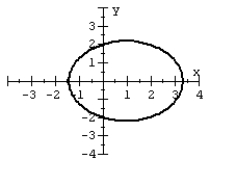
B)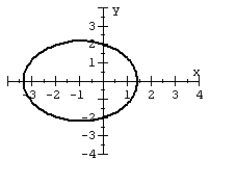
C)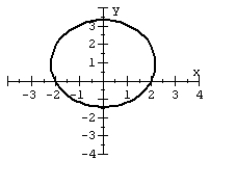
D)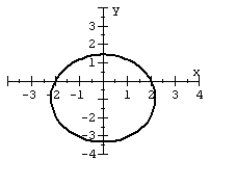

A)

B)

C)

D)


فتح الحزمة
افتح القفل للوصول البطاقات البالغ عددها 230 في هذه المجموعة.
فتح الحزمة
k this deck
55
For the polar equation, (a) Identify the conic as either a parabola, ellipse, or hyperbola; (b) find the eccentricity and vertex (or vertices); and (c) graph.



فتح الحزمة
افتح القفل للوصول البطاقات البالغ عددها 230 في هذه المجموعة.
فتح الحزمة
k this deck
56
For the polar equation, (a) Identify the conic as either a parabola, ellipse, or hyperbola; (b) find the eccentricity and vertex (or vertices); and (c) graph.



فتح الحزمة
افتح القفل للوصول البطاقات البالغ عددها 230 في هذه المجموعة.
فتح الحزمة
k this deck
57
For the polar equation, graph the conic. 
A)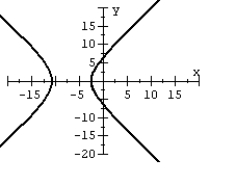
B)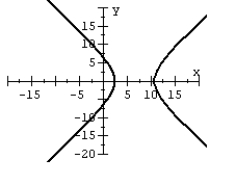
C)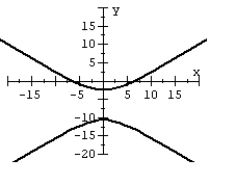
D)

A)

B)

C)

D)


فتح الحزمة
افتح القفل للوصول البطاقات البالغ عددها 230 في هذه المجموعة.
فتح الحزمة
k this deck
58
For the polar equation, graph the conic. 
A)
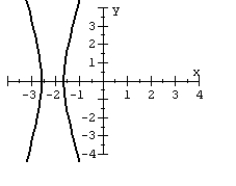
B)
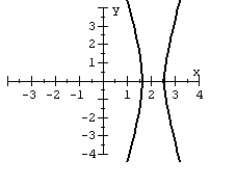
C)

D)


A)

B)

C)

D)


فتح الحزمة
افتح القفل للوصول البطاقات البالغ عددها 230 في هذه المجموعة.
فتح الحزمة
k this deck
59
For the polar equation, (a) Identify the conic as either a parabola, ellipse, or hyperbola; (b) find the eccentricity and vertex (or vertices); and (c) graph.



فتح الحزمة
افتح القفل للوصول البطاقات البالغ عددها 230 في هذه المجموعة.
فتح الحزمة
k this deck
60
For the polar equation, (a) Identify the conic as either a parabola, ellipse, or hyperbola; (b) find the eccentricity and vertex (or vertices); and (c) graph.



فتح الحزمة
افتح القفل للوصول البطاقات البالغ عددها 230 في هذه المجموعة.
فتح الحزمة
k this deck
61
For the polar equation, (a) Identify the conic as either a parabola, ellipse, or hyperbola; (b) find the eccentricity and vertex (or vertices); and (c) graph.



فتح الحزمة
افتح القفل للوصول البطاقات البالغ عددها 230 في هذه المجموعة.
فتح الحزمة
k this deck
62
For the polar equation, graph the conic. 
A)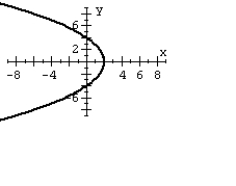
B)
C)
D)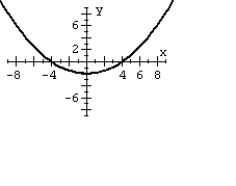

A)

B)

C)

D)


فتح الحزمة
افتح القفل للوصول البطاقات البالغ عددها 230 في هذه المجموعة.
فتح الحزمة
k this deck
63
For the polar equation, graph the conic. 
A)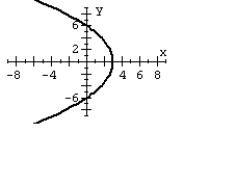
B)
C)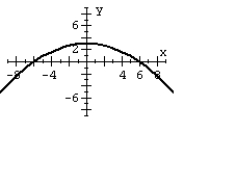
D)

A)

B)

C)

D)


فتح الحزمة
افتح القفل للوصول البطاقات البالغ عددها 230 في هذه المجموعة.
فتح الحزمة
k this deck
64
Identify the conic (parabola, ellipse, or hyperbola) that is represented by the equation.



فتح الحزمة
افتح القفل للوصول البطاقات البالغ عددها 230 في هذه المجموعة.
فتح الحزمة
k this deck
65
Identify the conic (parabola, ellipse, or hyperbola) that is represented by the equation.



فتح الحزمة
افتح القفل للوصول البطاقات البالغ عددها 230 في هذه المجموعة.
فتح الحزمة
k this deck
66
Identify the conic (parabola, ellipse, or hyperbola) that is represented by the equation.



فتح الحزمة
افتح القفل للوصول البطاقات البالغ عددها 230 في هذه المجموعة.
فتح الحزمة
k this deck
67
Identify the conic (parabola, ellipse, or hyperbola) that is represented by the equation.



فتح الحزمة
افتح القفل للوصول البطاقات البالغ عددها 230 في هذه المجموعة.
فتح الحزمة
k this deck
68
Identify the conic (parabola, ellipse, or hyperbola) that is represented by the equation.



فتح الحزمة
افتح القفل للوصول البطاقات البالغ عددها 230 في هذه المجموعة.
فتح الحزمة
k this deck
69
Identify the conic (parabola, ellipse, or hyperbola) that is represented by the equation.



فتح الحزمة
افتح القفل للوصول البطاقات البالغ عددها 230 في هذه المجموعة.
فتح الحزمة
k this deck
70
(a) Identify the type of conic by the discriminant, (b) transform the equation in x and y into an equation in X and Y (without an XY term) by rotating the x- and y-axes by an angle of θ to arrive at the new X- and Y-axes, and (c) graph the resulting equation (showing both sets of axes).



فتح الحزمة
افتح القفل للوصول البطاقات البالغ عددها 230 في هذه المجموعة.
فتح الحزمة
k this deck
71
(a) Identify the type of conic by the discriminant, (b) transform the equation in x and y into an equation in X and Y (without an XY term) by rotating the x- and y-axes by an angle of θ to arrive at the new X- and Y-axes, and (c) graph the resulting equation (showing both sets of axes).



فتح الحزمة
افتح القفل للوصول البطاقات البالغ عددها 230 في هذه المجموعة.
فتح الحزمة
k this deck
72
If the xy-coordinate axes are rotated 45°, find the XY coordinates of the point (x, y) = (3, -6).

فتح الحزمة
افتح القفل للوصول البطاقات البالغ عددها 230 في هذه المجموعة.
فتح الحزمة
k this deck
73
If the xy-coordinate axes are rotated 30°, find the XY coordinates of the point (x, y) =

.

.

فتح الحزمة
افتح القفل للوصول البطاقات البالغ عددها 230 في هذه المجموعة.
فتح الحزمة
k this deck
74
If the xy-coordinate axes are rotated 60°, find the XY coordinates of the point (x, y) =

.

.

فتح الحزمة
افتح القفل للوصول البطاقات البالغ عددها 230 في هذه المجموعة.
فتح الحزمة
k this deck
75
If the xy-coordinate axes are rotated 45°, find the XY coordinates of the point (x, y) = (-33, 3).

فتح الحزمة
افتح القفل للوصول البطاقات البالغ عددها 230 في هذه المجموعة.
فتح الحزمة
k this deck
76
If the xy-coordinate axes are rotated 30°, find the XY coordinates of the point (x, y) =

.

.

فتح الحزمة
افتح القفل للوصول البطاقات البالغ عددها 230 في هذه المجموعة.
فتح الحزمة
k this deck
77
If the xy-coordinate axes are rotated 60°, find the XY coordinates of the point (x, y) =

.

.

فتح الحزمة
افتح القفل للوصول البطاقات البالغ عددها 230 في هذه المجموعة.
فتح الحزمة
k this deck
78
Determine the angle of rotation necessary to transform the equation in x and y into an equation in X and Y with no XY term. Round to one decimal place.



فتح الحزمة
افتح القفل للوصول البطاقات البالغ عددها 230 في هذه المجموعة.
فتح الحزمة
k this deck
79
(a) Identify the type of conic by the discriminant, (b) transform the equation in x and y into an equation in X and Y (without an XY term) by rotating the x- and y-axes by an angle of θ to arrive at the new X- and Y-axes, and (c) graph the resulting equation (showing both sets of axes).



فتح الحزمة
افتح القفل للوصول البطاقات البالغ عددها 230 في هذه المجموعة.
فتح الحزمة
k this deck
80
Graph the second-degree equation. (Hint: Transform the equation into an equation that contains no xy term).



فتح الحزمة
افتح القفل للوصول البطاقات البالغ عددها 230 في هذه المجموعة.
فتح الحزمة
k this deck








